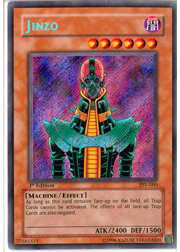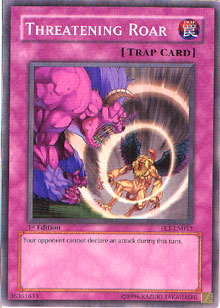Everyone has eagerly anticipated this event, and now we get to see what big cards are popping up. We’re halfway through Round 4, and the popular cards of the day thus far may prove to be surprising.
Magic Reflector
 Magic Reflector has seen play in a variety of decks for a variety of uses. There have been some field cards in use today, and Reflector has been used to protect the more important ones like A Legendary Ocean and Necrovalley. Okay, so there’s nothing new there. It’s also being used to guard the now-limited Level Limit - Area B from destruction, which is an interesting adaptation to the new format, though it’s only a fresh spin on an old concept.
Magic Reflector has seen play in a variety of decks for a variety of uses. There have been some field cards in use today, and Reflector has been used to protect the more important ones like A Legendary Ocean and Necrovalley. Okay, so there’s nothing new there. It’s also being used to guard the now-limited Level Limit - Area B from destruction, which is an interesting adaptation to the new format, though it’s only a fresh spin on an old concept.
The one use that we haven’t seen much of in the past is the protection of Wave-Motion Cannon. Several duelists who were splashing Wave-Motion Cannon have now splashed Magic Reflector too, creating a situation in which just a single topdeck can’t disrupt the Cannon. It’s brutal, and it’s taking a lot of game 1 wins while forcing the opponent to side deck hard into spell and trap destruction. For anybody who isn’t maindecking a pair of Dust Tornado, it’s just brutal, and since many duelists now rely on Mobius the Frost Monarch instead of Tornado, it’s ripping up a lot of matches.
 Jinzo
Jinzo
Jinzo’s back! As duelists progress past the mindset of card advantage as the only thing that’s important, a near-forgotten piece of game theory (momentum) is starting to see a lot more emphasis. While tempo is concerned with the rate at which cards are exchanged and used, momentum denotes the flow of battle. If a duelist is playing passively and is taking attacks, their opponent controls the momentum of the game. If a duelist is doing most of the attacking, it can be said that the momentum of the duel is in their favor. When the momentum is in your favor, it’s going to be inherently easier to attack, because your opponent controls fewer big beatsticks to clog your path to victory, and fewer threats if you crash into a board-clearing trap.
Being the aggressor is good, because even if only half of your attacks hit the opponent, you’re gaining card and life point advantage. Though something like Mobius the Frost Monarch can provide card advantage through its effect, it can’t directly influence momentum with that effect: it needs to attack to have a chance at doing so. Jinzo on the other hand, creates no card advantage with its effect. However, it does free its controller to summon and attack with near-impunity, blocking threats that directly influence momentum. Sakuretsu Armor, Mirror Force, and more are all shut down by Jinzo.
Jinzo allows a duelist to over-extend without the fear of too much reprisal, and while the importance of that fact has long been appreciated in Return decks, only now, with the environment taking such aggressive turns, has that ability become useful to the average duelist again. Deck Devastation Virus and Nobleman of Crossout have scared away many of the game’s smaller flip effects, and that’s left the door open for wild over-extensions with multiple monsters attacking in a single turn. While that certainly wasn’t unheard of in the last format, it’s happening a lot more today than it ever did in the past six months.
That makes Jinzo a game-winning card once again, and it hasn’t gone unnoticed. There have been a lot of Jinzos hitting the top tables today, and duelists have been making the most of the opportunities it provides. With Treeborn Frog making tributes more viable than ever before, it’s a great time to be a huge fleshy robot.
 Threatening Roar
Threatening Roar
This one’s just weird. I’ve seen Threatening Roar in side decks everywhere today, which makes a lot of sense. The new format’s really aggressive, right? So Return will be at the top of the heap yet again, and depriving Return of its battle phase is a good thing. While Waboku can be used as well, it won’t shut down Mystic Swordsman LV2, giving Threatening Roar the edge.
That explains the side deck use, but it doesn’t explain why I’ve seen Threatening Roar in so many main decks. A lot of duelists using Treeborn Frog are running Threatening Roar in the core support engine, using it as a replacement for Time Seal. While Time Seal obviously accomplishes a far different goal, both traps are chainable and can be easily cleared off the field in order to ensure that Frog gets to hop back into a monster zone.
The interesting thing is that Time Seal wasn’t really useful when things were going badly. Though it might prevent an opponent from drawing another monster to add to your beating, it did nothing to actually get you to the next turn: that Frog isn’t so useful if you can’t stay alive until your next standby phase. Threatening Roar gives a tribute-heavy deck the opportunity to draw one more card, and if that one card is something like Mobius or Zaborg, that can be the difference between a win or a loss.
Of course, it’s a great card against Mobius itself, too. Chainable to Mobius’s effect, Roar shuts down the Frost Monarch’s ability to generate any swing in momentum whatsoever: as mentioned in the Jinzo discussion, Mobius’s effect doesn’t actually generate momentum, and if you remove its ability to attack you’ve really stolen its thunder. If we assume Mobius is targeting two set spell or trap cards, Threatening Roar basically turns a two-card loss plus a threat of additional loss through battle, into a one-card loss that’s balanced by the opponent’s tribute. Not only is it good math, it’s representative of the battle-centric philosophies we’re starting to see emerge in this format.
Slate Warrior
Carlos Santiago is now 3-0 with Scoop’s Slate Warrior-heavy Return deck. The big surprise? He hasn’t activated Return from the Different Dimension yet. At all. Not once. Slate Warrior is just that good.
On offense, Slate Warrior can be a 1900 ATK beatstick brought from the hand. If it gets to flip from the field first, it becomes a ridiculous 2400 ATK. A lot of factors in the new format mix to make those numbers more important than they used to be.
First off, most duelists are playing aggressive, beatdown-oriented decks that look to attack a lot more often than was average in the last format. That means there are more face up monsters that are intended primarily for battle, like D. D. Survivor, Kycoo the Ghost Destroyer, and more are making an increased number of appearances. Anything that’s intended for battle with 1850 ATK or less gets destroyed by an attack from Slate Warrior, meaning card and field advantage for the Slate’s controller. While this is obviously very basic, the frequency with which it’s happening makes it noteworthy.
Second, D. D. Assailant is no longer being played in pairs. It can’t be, since it’s now a limited card. That makes for one less threat against big monsters, and Slate Warrior is no exception. The era of monsters being ripped off the field a turn after they’re summoned appears to be over, at least for the moment. Mystic Tomato and Apprentice Magician engines (which support Newdoria and Old Vindictive Magician respectively) have taken a back seat to an increased number of big attackers, and the result is that there’s significantly less monster destruction in the format. Again, it’s all aces for Slate Warrior, especially if he’s got 2400 ATK.
Of all the tribute monsters that could be seeing play right now, Dark Ruler Ha Des has yet to re-appear. If he does, his extra 50 ATK might rain on Slate Warrior’s parade, but for now, a Slate that can stay set on the field for one turn can easily kamikaze the top three tribute monsters in the format. While that’s a card-for-card exchange on the surface, remember that Jinzo or Mobius needed to be tributed for, while Slate Warrior didn’t. Even if the Slate can’t stay set, it can easily reduce those monsters to a more manageable 1900 ATK.
In addition, it can be combined with Book of Moon and Tsukuyomi to turn a 1900 ATK Slate Warrior into one with 2400 ATK, letting you have the best of both worlds. Normal summon Slate in a pinch when you need it, and then buff it up to 2400 ATK later. It’s even more deadly if you’re playing Book of Moon against something like a Smashing Ground, gaining card advantage while setting yourself up for a big attack.
Oh, and Slate Warrior beats the tar out of Cyber Dragon. I hear that’s kind of good. You know. Just a little.
We’ll probably see more popular tech as the day goes on, but for now, these four cards are the surprises that are defining the field. Jinzo will probably become a staple of the format, Slate Warrior will make a huge impact, and Threatening Roar is a tossup that could go either way.
If you’re looking to innovate your local metagame, try these out. Of the four, three of them are highly splashable, and can fit into a wide variety of decks. Give them a shot yourself!